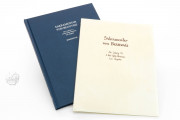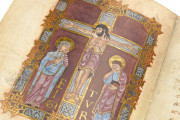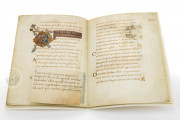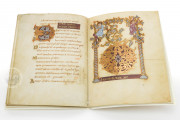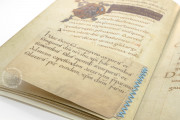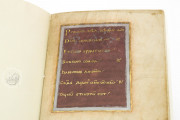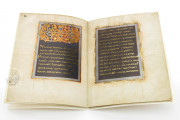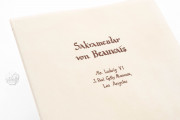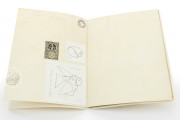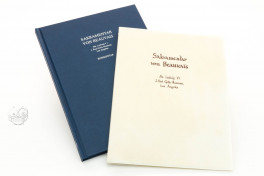A rare survival of manuscript art from early Capetian France, the Sacramentary of Beauvais is distinguished for its inventive figural compositions, complex interlace, and lavish use of gold and silver paint. A fragment of a once-extensive deluxe Christian liturgical book, it is enhanced with gold and purple and features a full-page miniature of Crucifixion. It was probably commissioned by Roger, Bishop of Beauvais, around 1000 and created there for his cathedral church.
When complete, the Sacramentary of Beauvais comprised prayers recited by the officiating priest at mass. Reduced to ten leaves by a book dealer, the surviving fragment undoubtedly contains the original manuscript's most attractive and lavish pages.
Dazzling Illumination
The manuscript's full-page Crucifixion appears at the Te igitur, the opening prayer of the Canon of the mass (the prayers said as the Eucharistic elements are prepared). Also surviving are an impressive incipit page for the Easter prayers, a monogram of gold and silver interlace, and three large interlace initials followed by gold rubrics on purple ground.
Emotive Figures
The treatment of the figures in the Crucifixion is especially engaging: the gestures and countenances of the Virgin Mary and Saint John are infused with mournful pathos (fol. 2v). The men clambering up the gold vines of the complex interlace that extends from the nearly full-page Uncial D of the incipit page to Easter are lively and dynamic (fol. 9r).
Ancient Scripts for Display
The main text, written by a single scribe, is in Caroline Minuscule in brown ink. Rubrics identifying individual prayers are in Uncials (a text script of late antiquity), and those identifying feast days are in gold Rustic Capitals (another antique script) on painted purple bands. The three display text pages feature a combination of Uncial and Rustic Capitals letterforms in gold on purple grounds.
The Mystery of an Italian Scribe
The sacramentary's scribe also wrote a Gospel lectionary known as the Gaignières Gospels (Paris, Bibliothèque nationale de France, MS lat. 1126) and a small prayer book (London, British Library, MS Egerton 3763) made for Archbishop Arnulph II of Milan (d. 1018). He may have been an itinerant secular cleric or layman trained in Milan who specialized in luxury liturgical books.
From Liturgical Book to Collectable Fragment
The sacramentary was still complete when it was first described around 1685. By the nineteenth century, the manuscript had been reduced to ten leaves and was acquired by Walter Sneyd (1809-1888). It then passed through the collections of Charles Fairfax Murray (1849-1919) and Charles William Dyson Perrins (1864-1958) before being acquired by Peter and Irene Ludwig. The Ludwig collection of illuminated manuscripts was purchased by the J. Paul Getty Museum in 1983.
We have 2 facsimiles of the manuscript "Sacramentary of Beauvais":
- Das Sakramentar von Beauvais (Real Gold Edition) facsimile edition published by Akademische Druck- u. Verlagsanstalt (ADEVA), 2010
- Das Sakramentar von Beauvais (Standard Edition) facsimile edition published by Akademische Druck- u. Verlagsanstalt (ADEVA), 2010


